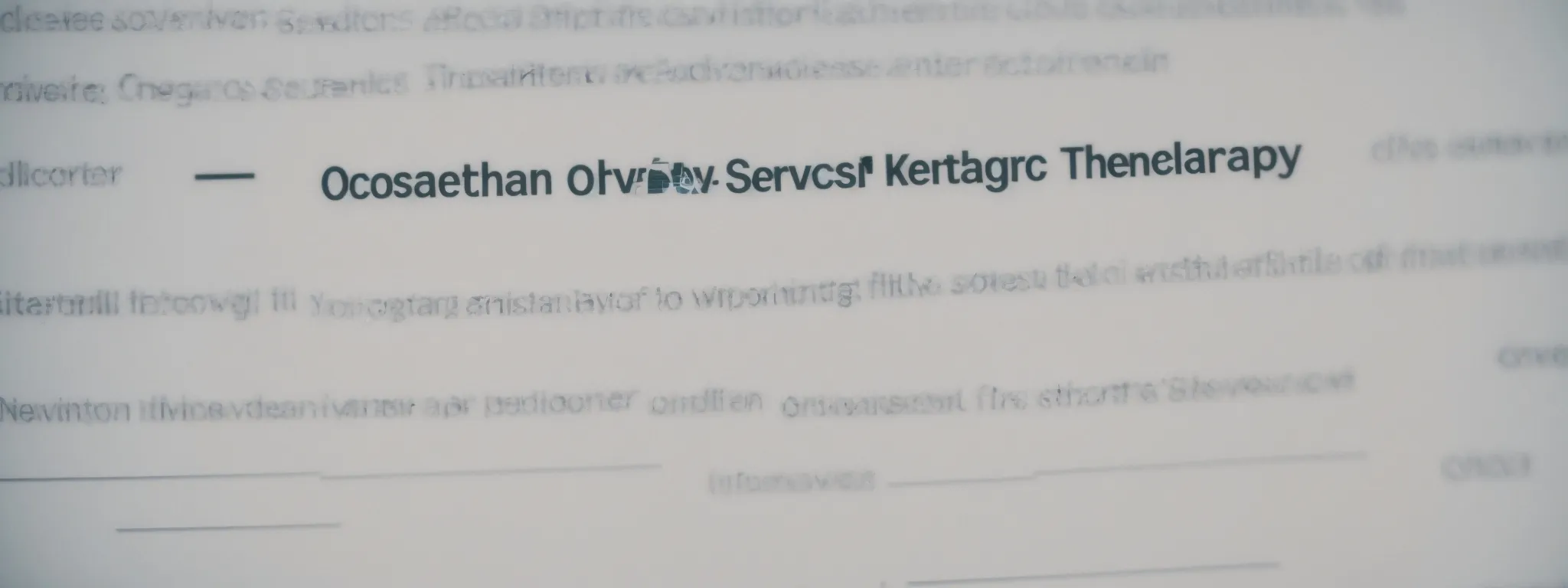SEO for Occupational Therapy Services Websites
Optimizing Your Occupational Therapy Services Website for Better Search Engine Visibility Occupational therapists and healthcare providers continuously seek enhanced visibility for their services; optimizing a website for […]
Optimizing Your Occupational Therapy Services Website for Better Search Engine Visibility
Occupational therapists and healthcare providers continuously seek enhanced visibility for their services; optimizing a website for search engines is a critical step in achieving this goal.
With the tailored guidance of LinkGraph’s SEO expertise, practitioners in the occupational therapy field, from assistants to licensed professionals, can elevate their online presence, connecting more effectively with patients, caregivers, and employers.
By understanding SEO basics and employing strategic content creation alongside technical improvements, websites dedicated to occupational therapy can climb the search engine rankings.
This article reveals how integrating LinkGraph’s proficient SEO services and Search Atlas SEO tool can transform a therapy website into a powerful digital asset.
Keep reading to discover the comprehensive pathway to search engine success, crafted precisely for the occupational therapy niche.
Key Takeaways
- SEO Is Vital for Occupational Therapy Service Websites to Improve Visibility and Client Engagement
- LinkGraph’s SEO Services and Search Atlas SEO Tool Help Optimize Content With Targeted Keyword Research
- Optimizing Site Architecture and on-Page Elements Like Titles and Meta Descriptions Boosts User Engagement
- Off-Page SEO Strategies, Including Backlinks and Client Testimonials, Enhance Site Authority and Trustworthiness
- Keeping Abreast of SEO Trends and Employing Analytics Tools Is Necessary for Evolving and Maintaining Online Visibility
Understanding SEO Basics for Your Therapy Website

Embarking on the journey of optimizing a website for search engines, particularly for those within the healthcare profession such as occupational therapy, begins with a grasp of Search Engine Optimization (SEO) fundamentals.
This integral digital marketing stratagem has the potential to enhance an occupational therapy provider’s visibility by propelling their site to the upper echelons of search engine results.
At the core of SEO lies the meticulous selection of niche keywords tailored to the distinct services offered by occupational therapists, steering the course for those in need of such specialized care to the appropriate practitioners.
Furthermore, the architecture of a website is not merely about aesthetic appeal; it requires a strategic design that caters to both the algorithms of search engines and the user experience.
It is through the understanding and implementation of these foundational elements that an occupational therapy services website can truly flourish in the digital realm.
Define SEO and Its Importance for Occupational Therapy Sites
Search Engine Optimization, commonly known as SEO, is an essential tool for occupational therapy service websites that aspire to reach their targeted audience efficiently. It is the art and science of enhancing a website’s visibility within the organic results of search engines like Google, helping potential clients discover vital services offered by occupational therapists.
Recognizing the significance of SEO for occupational therapy sites illuminates the path to greater online presence and client engagement. By deploying effective SEO practices, such as keyword optimization and quality content creation, occupational therapy practitioners ensure that their services are not just visible, but also appealing to those seeking their expertise:
| SEO Aspect | Impact on Occupational Therapy Websites |
|---|---|
| Keyword Optimization | Attracts the right clientele by matching their search intent. |
| Quality Content | Establishes credibility and offers valuable information to visitors. |
| User Experience | Ensures that the site is navigable and keeps users engaged. |
Identify Your Occupational Therapy Niche Keywords
In the competitive landscape of online healthcare services, selecting precise keywords is paramount for occupational therapy websites aiming to capture the attention of search engines and potential clients. Swiftly rising above a sea of generic searches, pertinent terms such as “adaptive equipment for adults”, “occupational therapy interventions for mental health”, or “pediatric occupational therapy services” can connect an occupational therapist with the exact group seeking their specialized expertise.
LinkGraph’s adept SEO services aid occupational therapy websites in crafting an SEO strategy that incorporates Targeted Keyword Research, a critical component for attracting the right audience. Their meticulous approach to identifying optimal keywords for occupational therapy ensures that patient searches lead to meaningful connections with healthcare providers, thereby facilitating a treatment plan that aligns with their individual health conditions.
Discuss the Structure of an SEO-friendly Website
An SEO-friendly Website for occupational therapists must exhibit a well-designed structure that serves as the backbone for both user interaction and search engine algorithms. Robust site architecture allows for seamless navigation, ensuring that both prospective clients and search engines can find relevant content—such as detailed descriptions of occupational therapy interventions or information about certifications with ease.
The Strategic Placement of Quality Content, equipped with targeted keywords, across the website amplifies its relevance in search queries. Ensuring that elements such as page titles, headings, and meta descriptions accurately reflect the content of each page, tags it as a reliable resource for users seeking occupational therapy services.
| Website Element | Role in SEO |
|---|---|
| Site Architecture | Provides a clear and logical structure, facilitating easy navigation for users and crawlers. |
| Content Quality and Keyword Integration | Enhances visibility in search results, aligning with the specific needs of users looking for specialized therapy services. |
| Title Tags and Meta Descriptions | Offers a succinct preview of page content, influencing the click-through rate from the search results. |
Crafting Content That Ranks High in Searches

For an occupational therapy services website to demonstrate prominence in the digital landscape, it is essential to adopt SEO strategies that target high-ranking content.
This serves two pivotal roles: it positions the website as an authoritative source on occupational therapy topics, and it meets the search intent of users with precision and finesse.
Crafting content that resonates with user queries begins with the development of informative articles that delve into the specifics of occupational therapy practices.
By integrating long-tail keywords into the fabric of these articles, a website extends its reach to audiences that require comprehensive and specialized information.
Furthermore, the inclusion of engaging media such as images, videos, and infographics captivates visitors, encouraging prolonged interaction with the site, which is a signal to search engines of the site’s value and relevance.
Write Informative Articles on Occupational Therapy Topics
Effective SEO for occupational therapy websites necessitates the Crafting of Informative Articles that delve deep into the fabric of occupational therapy topics. These articles should serve not only to educate patients and caregivers, but also to showcase the breadth of knowledge and services offered by occupational therapists, positioning them as leaders in their field.
- Understanding Occupational Therapy: What Patients Should Know
- The Role of Occupational Therapy in Pain Management
- Maximizing Independence: Occupational Therapy Interventions for Adults
- Pediatric Occupational Therapy: Empowering Children to Thrive
- Exploring the Intersection of Occupational Therapy and Mental Health Care
Such content can reinforce how essential occupational therapy is in enhancing life skills and independence in patients recovering from injuries or dealing with chronic health conditions. It is these narratives that resonate with individuals requiring these services, guiding them to the suitable healthcare providers through informed decision-making.
Utilize Long-Tail Keywords in Your Content Strategy
Implementing long-tail keywords into the content strategy of occupational therapy services websites is a refined approach that addresses specific queries by a patient or caregiver. This strategy not only aligns seamlessly with search intent but it also fosters a connection between client needs and the specialized services offered, guiding them towards relevant and authoritative resources.
LinkGraph’s Search Atlas SEO tool excels in pinpointing these niche long-tail phrases, ensuring that occupational therapists successfully target the complexities of user search patterns. The tool’s precision in identifying such keywords embeds a layer of sophistication in content, elevating the profile of an occupational therapy practice’s digital presence among those requiring tailored healthcare solutions.
Incorporate Engaging Media to Keep Visitors on Your Site
In the realm of digital optimization for occupational therapy websites, incorporating engaging media is a potent catalyst for maintaining user interest. Multimedia elements like instructional videos on therapy exercises or interactive simulations of adaptive devices grant a dynamic edge to content, enhancing user engagement and contributing to decreased bounce rates on the site.
- Integrate accessible videos demonstrating occupational therapy interventions, enabling users to grasp treatment concepts visually.
- Employ interactive tools that simulate the use of adaptive equipment, offering a virtual hands-on experience.
- Curate image galleries showcasing the diversity of occupational therapy practices across various life skills and activities.
When a website utilizes such rich media, it not only entices visitors but also endorses the message that the therapeutic services it offers are cutting-edge and patient-oriented. This approach bolsters the credibility of the healthcare provider and underscores their commitment to offering comprehensive occupational therapy resources.
Strengthen Your Website With on-Page Optimization

Securing prominent search engine standings for an occupational therapy services website demands meticulous attention to on-page optimization.
This dynamic process involves refining each webpage to communicate the site’s value propositions to search engines precisely, thereby cultivating better visibility.
Key areas of focus encompass not only the optimization of title tags and meta descriptions reflective of the individual pages’ content but also delineating the array of occupational therapy services with lucid clarity.
Additionally, the judicious use of header tags alongside content rich in relevant keywords augments the site’s search relevance, establishing a stronghold in the digital terrain occupied by health professionals and therapy practitioners.
Optimize Title Tags and Meta Descriptions for Each Page
Occupational therapy websites stand to gain increased visibility through polished on-page SEO elements, particularly title tags and meta descriptions. These succinct snippets serve as a first impression in search results, succinctly conveying to potential clients the essence of the occupational therapy interventions on offer.
- Title tags should encapsulate the main topic of the page while incorporating targeted keywords to signal relevancy.
- Meta descriptions act as compelling summaries, inviting clicks by highlighting the unique aspects of occupational therapy services provided.
Strengthening the appeal of each page, clear and informative title tags and meta descriptions are essential tools. They guide users from the search results page to the occupational therapist’s digital domain, effectively bridging the gap between potential clients and specialized healthcare services.
Ensure Your Occupational Therapy Services Are Clearly Listed
For occupational therapy websites to effectively communicate their range of services, clarity in listing is imperative. A well-defined list of services, from pain management to adaptive training for daily living activities, must be presented in a manner that captures the specificity and the comprehensive nature of occupational therapy interventions. This draws in a relevant audience seeking precise therapeutic solutions.
LinkGraph’s SEO services specialize in optimizing content, ensuring that each occupational therapy service offered is highlighted and accessible. A clear, concise presentation of services not only aids search engines in indexing relevant offerings but also signals to clients the practical and life-enhancing benefits available through professional occupational therapy practitioners.
Implement Header Tags and Keyword-Rich Content
In the competitive realm of search engine rankings, the judicious implementation of header tags and keyword-rich content cannot be overstated for occupational therapy websites. Header tags, such as H1 through H6, organize content hierarchically and thematically, signposting to search engines the structure and priority of information within a page.
Accompanying these hierarchical markers, incorporating content saturated with relevant keywords propels an occupational therapy website’s searchability. Thoughtfully chosen keywords embedded into high-quality content ensure that each page resonates with the specific queries of individuals seeking occupational therapy services:
- Highlight the scope of occupational therapy interventions with accurately placed H1 tags.
- Use H2 and H3 tags to structure content about various therapeutic practices and outcomes.
- Ensure that keyword integration flows naturally within the text, enhancing readability for users and search engines alike.
Leveraging Off-Page SEO Techniques

While on-page optimization forms the bedrock of a fortified SEO strategy, the significance of off-page techniques for enhancing an occupational therapy services website’s search relevance cannot be ignored.
Off-page SEO extends the reach of a practitioner’s digital footprint beyond their website, creating a network of signals that boost search engine credibility and visibility.
From cultivating reputable backlinks through strategic guest blogging and partnerships to mastering the locality of search, these methods fortify the website’s standing within the digital ecosystem.
Encouraging satisfied clients to share their experiences also plays a pivotal role, adding authentic testimonials that endorse the site’s authority.
Altogether, these off-page SEO strategies orchestrate a comprehensive approach to nurturing an occupational therapy practice’s online presence.
Build Reputable Backlinks Through Guest Blogging and Partnerships
In the intricate dance of off-page SEO, one critical step occupational therapy services websites can take is to establish strong backlinks through guest blogging. By contributing valuable content to reputable sites within the healthcare sector, an occupational therapy practitioner can not only share their expertise but also create pathways back to their own website, thus enhancing its authority in the eyes of search engines.
Forming strategic partnerships plays an equally pivotal role in the off-page optimization process. Occupational therapy services gain amplified visibility through alliances with educational institutions, healthcare facilities, and professional organizations like the American Occupational Therapy Association. Such relationships not only lend credence to the therapy services provided but also bolster the website’s backlink profile, which is a vital component of a comprehensive SEO strategy.
Engage in Local SEO Tactics for Your Occupational Therapy Practice
Advancing the digital presence of an occupational therapy practice necessitates a sharp focus on local SEO tactics. By honing in on optimizations for local searches, a practice ensures that it prominently appears in the query results of potential clients within its geographical area.
Such fine-tuned local SEO tactics not only elevate the practice in search rankings but also drive foot traffic, fostering a direct line to those in need of rehabilitative services:
- Optimization of Google My Business listings amplifies visibility in local directories and maps.
- Local keyword integration, such as “occupational therapy near me” or location-specific services, heightens relevance in search engines for community members on the lookout for therapy services.
- Cultivating local reviews and ratings strengthens the practice’s reputation and search engine trustworthiness.
Implementing these strategies, occupational therapists ensure that their digital presence resonates with the community they serve, leading those in search of assistance straight to their doorstep.
Encourage Client Reviews to Bolster Site Authority
In the digital sphere, client testimonials are a powerful form of currency, particularly for occupational therapy practitioners seeking to validate their site’s authority. Encouraging satisfied individuals to leave positive reviews not only reflects real-world effectiveness but also plays a crucial role in augmenting the site’s reputation and search engine rankings.
These client endorsements, strategically displayed across digital platforms, may significantly influence prospective clients’ decisions, while simultaneously signaling to search engines the trustworthiness and quality of the occupational therapy services offered:
| Client Review Factor | Impact on Site Authority |
|---|---|
| Positive Testimonials | Enhances credibility and encourages user trust. |
| Quantity of Reviews | Reflects a well-established practice with a substantial client base. |
| Review Quality | Indicates the level of client satisfaction and service efficacy. |
| Search Engine Perception | Contributes to improved SEO through evidencing high-quality patient experiences. |
Technical SEO Essentials for a Seamless User Experience

Navigating the labyrinth of technical SEO is essential for occupational therapy websites aiming to provide a frictionless user experience while enhancing their search engine rankings.
Crafting a digital presence that is not only informative but also technically sound requires attention to the website’s mobile-friendliness, page loading speeds, and the integrity of site architecture.
Occupational therapists and their digital teams must prioritize these backend optimizations to ensure that when users, clients, or fellow healthcare professionals visit their site, they are greeted with an efficient, user-centric interface that aligns with modern browsing habits and search engine requirements.
Make Sure Your Website Is Mobile-Friendly
Ensuring a website’s mobile-friendliness is not a mere suggestion but a necessity in today’s digital landscape. Occupational therapists must recognize that a significant portion of their audience will access their services through mobile devices; thus, the creation of responsive designs that adapt to varying screen sizes and resolutions is paramount.
An optimal mobile experience facilitates seamless navigation and interaction for the user, encouraging prolonged engagement with the contents of an occupational therapy website. Adjusting text size and touchscreen-friendly interface elements allows potential clients to browse therapy services and resources effortlessly:
| Mobile Design Element | Impact on User Experience |
|---|---|
| Responsive Layout | Adapts to any device, ensuring content is always accessible and legible. |
| Touchscreen Navigation | Enables intuitive site interaction, vital for users seeking information quickly. |
| Optimized Media | Accelerates page load times, a crucial factor for maintaining user attention. |
Improve Loading Speeds for Better Engagement
Occupational therapy websites must prioritize Swift Page Load Times to facilitate better user engagement and retention rates. A lagging interface can deter potential clients, tarnishing the first impression of a healthcare provider’s online service platform.
LinkGraph’s comprehensive SEO services understand this imperative, Optimizing Website Technicalities to reduce loading times. This specialized attention ensures that every client who seeks occupational therapy interventions experiences a website that responds promptly, mirroring the efficiency of professional healthcare services.
Fix Broken Links and Crawl Errors Regularly
Maintaining the structural integrity of an occupational therapy services website is pivotal, demanding regular audits for broken links and crawl errors. Such issues, if not addressed promptly, can severely impede a website’s usability, leading to a disappointing user journey and a diminished trust in the provided therapy services from both users and search engines.
Occupational therapists must recognise that the health of their website is an ongoing concern, akin to the consistent care they provide to patients. By employing regular maintenance, therapy websites ensure that all paths lead prospective clients to accurate and relevant information, thereby sustaining a professional image and bolstering search engine confidence in the site:
- Scan the website periodically to uncover any broken links that could frustrate users and lead them astray from valuable content.
- Resolve crawl errors immediately to ascertain that search engines effectively index the website, confirming its inclusion in search results.
- Regularly update and redirect old pages to reflect current services and resources, thus maintaining a dynamic and engaging website environment.
Measuring and Adapting Your SEO Strategy

In an ever-evolving digital marketplace, the successful optimization of an occupational therapy services website demands rigorous monitoring and adaptive strategies.
With an array of analytics tools at their disposal, therapists can scrutinize the performance of their digital presence, informing pivotal adjustments to their SEO tactics.
Data-driven insights are instrumental as providers refine their keyword strategies and content creation, ensuring alignment with the most pressing needs and interests of their audience.
Remaining agile and informed of the latest SEO evolutions enables occupational therapists to continuously elevate their online visibility, securing a dominant stance in the competitive healthcare sector.
Use Analytics Tools to Track Website Performance
Occupational therapy service providers benefit immensely from employing analytic tools to monitor their website’s performance. These tools provide key insights into visitor behavior, traffic sources, and engagement levels, equipping practitioners with the data required to make informed decisions about their SEO strategy.
- Gauging visitor interaction unveils which aspects of the website are most engaging and which may need refinement.
- Assessing referral sources helps identify successful external marketing efforts or partnerships that drive traffic.
- Monitoring engagement levels guides content updates and improves user experience to keep the website dynamic and relevant.
Through diligent tracking of website analytics, occupational therapy practitioners can adapt their SEO approach adeptly, ensuring sustained visibility and relevance in search engine results. This ongoing process of analysis and adjustment is critical for achieving and maintaining optimal search engine ranking positions, thereby attracting a larger audience in need of occupational therapy services.
Refine Your Keywords and Content Based on Data Insights
Occupational therapy practitioners Benefit From the Wealth of Insights made available through meticulous analysis of search data, illuminating the effectiveness of current keywords and the resonance of content with their target audience. By continually refining keyword selection and tailoring content to align with data-driven insights, they sharpen their website’s competitive edge and ensure their services meet the specific needs of those searching for occupational therapy interventions.
LinkGraph’s SEO services provide occupational therapy websites with the advanced capabilities to parse through analytics, identifying underperforming keywords and uncovering topics that captivate and engage users. This empowers practitioners to dynamically adjust their content strategy, optimizing their digital presence for search engines and solidifying their place as go-to resources in the occupational therapy sector.
Stay Updated With the Latest SEO Trends for Occupational Therapy
Remaining at the forefront of SEO developments is pivotal for occupational therapy practitioners intent on maintaining and elevating their website’s visibility. By staying abreast of algorithm changes and emerging SEO practices, these healthcare professionals ensure their online presence continually aligns with current standards, drawing a consistent stream of relevant traffic to their services.
The dedication to ongoing education in SEO trends allows occupational therapy service websites to adapt swiftly to digital market shifts. For instance, as voice search becomes increasingly prevalent, optimizing content for conversational queries can attract a broader audience, putting practitioners at the cutting edge of the evolving search landscape.
Conclusion
To optimize an occupational therapy services website for better search engine visibility, understanding and implementing key SEO strategies is paramount.
By strategically identifying niche keywords, structuring a user-friendly website, and creating content that addresses specific patient needs, practitioners can enhance their online presence.
Including long-tail keywords and engaging multimedia further enriches the user experience, keeping visitors engaged.
On-page optimization, such as refining title tags and headers, ensures that services are discoverable and that content aligns with search queries, establishing a strong digital profile.
Complementing on-page efforts with off-page techniques like building backlinks, focusing on local SEO, and encouraging client reviews bolsters the site’s authority.
Furthermore, addressing technical SEO by optimizing for mobile use, improving loading speeds, and regularly fixing website errors provides a seamless user experience.
Continuous tracking and adapting of SEO strategies through analytics and staying up-to-date with the latest trends are crucial for maintaining the website’s competitive edge.
In essence, by diligently optimizing their website, occupational therapy practitioners can significantly improve their visibility in search results, connecting them more effectively with those seeking their specialized services.















































































